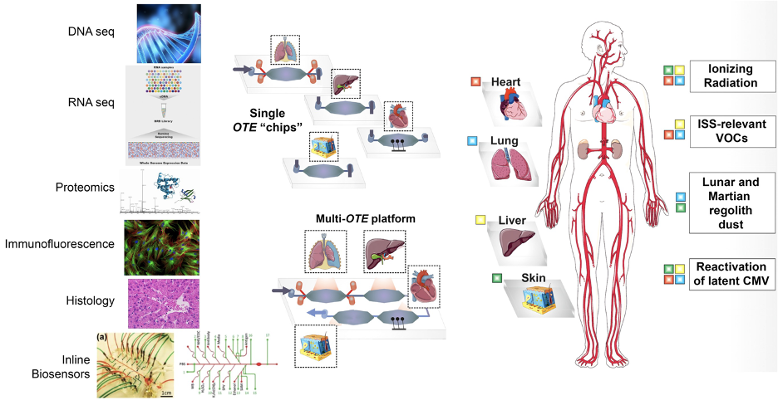Long-lived Single- and Multi-organ Tissue Equivalent (OTE) Platforms to Model the Response of Human Tissues to Various Stressors
Science Objectives
During future missions beyond low Earth orbit such as those planned to the Moon, Mars, and near-Earth asteroids, astronauts will be exposed to extreme physiological stressors including space radiation and conditions of microgravity. Both can produce significant untoward effects on human physiology, impacting multiple tissues and negatively impacting immunity, enabling reactivation of latent viruses that can lead to pathology in a variety of tissues/organs. In addition to these obvious stressors, human spaceflight operations also present unique toxicological challenges and risks to human health due to excess off-gassing of materials and utility compounds present within the extremely confined living space. This can expose astronauts to potentially harmful levels of a wide range of volatile organic compounds (VOCs). Looking beyond the risks inherent to all space missions, with NASA’s plans to visit the Moon and Mars and have astronauts remain on the surface for an extended period, exposure to various ultrafine dusts, such as lunar regolith dust, is also recognized as a serious health concern. The Long-lived Single- and Multi-organ Tissue Equivalent (OTE) Platforms to Model the Response of Human Tissues to Various Stressors investigation will use highly innovative human organ tissue equivalents (OTEs) to obtain mechanistic insight into the response of multiple different human tissues to each of these spaceflight stressors, with the long-term goal being to use the information gained to devise safe and effective countermeasures to protect astronauts during long duration space missions.

Experiment Description
While a great deal of data has been collected over the past decades on the biological effects of these various stressors, nearly all studies have been performed only in rodents making risk extrapolation to humans difficult. In order to better estimate astronaut risk and identify viable countermeasures, there is a critical need to develop and use physiologically relevant human tissue models. The Long-lived Single- and Multi-organ Tissue Equivalent (OTE) Platforms to Model the Response of Human Tissues to Various Stressors investigation will use a human “body-on-a-chip” (hBoC) in which microengineered 3D organ tissue equivalents (OTEs) of 12 different human tissues (cardiac, brain, bone marrow, lung, liver, testis/ovary, intestine, skin, and vasculature) are created with primary cells. This can be maintained long-term, retain normal functionality, used to identify drug toxicities, and study the biological response to various stressors.
Space Applications
These studies will provide the first-ever mechanistic data on the biological response of four major human tissues/organs to several of the major stressors present during spaceflight. The deeper understanding of the response of each of these tissues/organs to each stressor will pave the way for the development of safe and effective countermeasures to protect astronauts from these potential hazards during missions in deep space and on the Lunar/Martian surface.
Earth Applications
By extending the lifespan of the liver, lung, and skin OTEs to 6 months (the current cardiac OTE already maintains viability and function for 6 months), it will be possible to use this platform to study the biological effects of chronic exposure to various environmental stressors, degenerative disorders, and disease progression – undertakings that are not currently possible without the use of animal models as surrogates for the human response.
Team
Principal Investigator
Christopher D. Porada, PhD
Wake Forest University School of Medicine, Winston-Salem, North Carolina, United States
Co-Investigators
Graça Almeida-Porada, MD, PhD
Wake Forest University School of Medicine, Winston-Salem, North Carolina, United States
Anthony Atala, MD
Wake Forest University School of Medicine, Winston-Salem, North Carolina, United States
Colin Bishop, PhD
Wake Forest University School of Medicine, Winston-Salem, North Carolina, United States
Alan Jacobson
Wake Forest University School of Medicine, Winston-Salem, North Carolina, United States
Sean Murphy, PhD
Wake Forest University School of Medicine, Winston-Salem, North Carolina, United States
Thomas Shupe, PhD
Wake Forest University School of Medicine, Winston-Salem, North Carolina, United States
Yu Shrike Zhang
Wake Forest University School of Medicine, Winston-Salem, North Carolina, United States






























